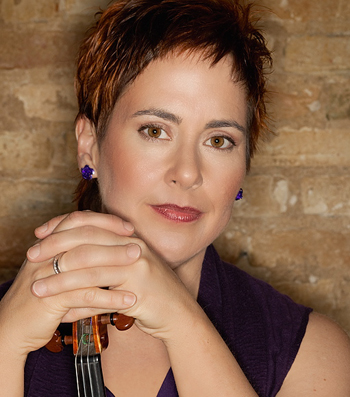Orchestra To Envision 'Divine' With Internationally Renowned Violinist
Nov. 2, 2012
SHSU Media Contact: Kim Mathie
The SHSU Symphony Orchestra will present a “Classical (R)evolution” that begins with music expressing a vision of the divine and journeys toward a passionately earthy realm in their upcoming concert on Saturday (Nov. 10).
 |
| Internationally renowned violin soloist Dylana Jenson will join the SHSU Symphony Orchestra in one of her areas of expertise—the music of Pyotr Tchaikovsky—on Nov. 10. |
Joined by internationally renowned violin soloist Dylana Jenson, the orchestra concert will begin at 7:30 p.m. in the James & Nancy Gaertner Performing Arts Center Payne Concert Hall.
“We’re getting the opportunity to hear and collaborate with one of the greatest living violinists,” said Zachary Carrettin, director of orchestral studies. “Ms. Jenson is an absolute virtuosa.”
Together they will perform “Violin Concerto in D Major, op 35” by Pyotr Tchaikovsky, a composer whose work helped make Jenson famous.
In 1978, Jenson became the youngest person, as a woman and an American, to win the silver medal in the Tchaikovsky Violin Competition in Moscow, which was part of the Soviet Union at the time.
“Ms. Jenson’s approach to the violin has a clear lineage back to Tchaikovsky,” Carrettin said. “Her teacher studied with the violinist for whom Tchaikovsky initially dedicated this concerto.
“Ms. Jenson is a Russian school violinist—her style of playing, her bowing, her physiological approach to the instrument and her musical approach are informed by and contribute to a wonderful artistic tradition, represented by such individuals as Jascha Heifetz and Nathan Milstein a few decades ago,” he said. “So we’re really getting a very authentic take on Tchaikovsky.”
Tchaikovsky’s “Violin Concerto in D Major, op 35” is “an expansive orchestration,” Carrettin said.
“It’s all fiery, rich violin playing, melting melodies and scores of notes whizzing by at light speed,” he said. “Ms. Jenson puts the bow on the string, and it’s such powerful violin playing; very commanding.”
While Ms. Jenson’s performance illustrates the earthy and visceral with Tchaikovsky’s “Violin Concerto,” the program begins on an esoteric, mystical plane.
“The further you go back in music history, the more concerned composers are with the beyond or the divine,” Carrettin said. “The later music, for example—and especially after the 1800s and to the present—the more the music concerns itself with life on earth. There are many exceptions, usually works at the end of a composer’s life, during which time almost every composer searches further, internally and externally.”
Carrettin’s program illustrates this descent from the divine to the earthly beginning with Giovanni Gabrieli’s “Canzona in the Ninth Mode” from “Sacrae Symphoniae,” written in 1597 for brass instruments.
“This piece was written for the church of San Marco in Venice to create a sort of transcendental experience in the church for the listener,” explained Carrettin. “It has a reverential quality, and it is full of hope.”
Carrettin places the brass instruments above the orchestra in the choral balcony on both sides so that the music is stereophonic.
“I hope that it will clean out our ears so that we start off the evening’s experience with a heightened awareness,” he said.
The program then transitions to F.J Haydn’s “Symphony No. 49 in F minor,” or “la Passione.”
“Haydn starts this piece as if it’s from another planet,” said Carrettin. “It’s ominous, foreboding, like a hushed whisper that makes you a little nervous for what’s coming.”
Written during Haydn’s “Strum und Drang” period, “Symphony No. 49 in F minor” can easily be characterized as dark and driving.
“While it’s classical in form, it’s more like the early romantic works in its delivery of raw emotion,” said Carrettin. “It’s not dainty at all.”
After intermission, Carrettin completes the musical descent towards the inner emotional life of the individual with Tchaikovsky’s “Violin Concerto.”
“Tchaikovsky is unabashed, passionate music making,” said Carrettin. “While other composers were more interested in the craft or in paying homage to a certain compositional trend, Tchaikovsky was, in a way, extremely honest. His music speaks, first and foremost, from a very emotional and vulnerable place.”
To best serve this evolution of music, Carrettin has been constantly altering the placement of the orchestra sections to best take advantage of the hall’s acoustics.
“We’ve completely changed everything from our last concert because I’m getting to know our hall much better,” said Carrettin. “What works so well for our bands and choirs, doesn’t work for the symphony orchestra. It is science best performed by trial and error.”
For the Haydn symphony Carrettin pulled the first violins to the edge of the stage, pulled the cellos back and turned their instruments towards the audience, split the string bass section so half is on one side and half on the other, and got rid of all the risers.
“The sound is five times better, rich with clarity and warmth. There is more ‘body’ to the overall sound,” said Carrettin. “Everyone is hearing a difference.”
Tickets are $15 adults, $12 seniors and $5 for SHSU students.
To make reservations, contact the GPAC Box Office at 936.294.2339 or to buy online, visit http://bit.ly/S9WNHX.
- END -
This page maintained by SHSU's Communications Office
Associate Director: Julia May
Manager: Jennifer Gauntt
Located in the 115 Administration Building
Telephone: 936.294.1836; Fax: 936.294.1834
Please send comments, corrections, news tips to Today@Sam.edu.

 SamWeb
SamWeb My Sam
My Sam E-mail
E-mail

